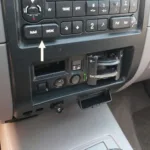Advanced high-end OBD2 scanners are no longer just tools for professional mechanics. As car technology becomes increasingly complex, these sophisticated diagnostic devices are becoming essential for serious car enthusiasts and even everyday drivers who want to understand and maintain their vehicles better. They offer a level of insight far beyond basic code readers, providing a wealth of data that can pinpoint issues, save you money on repairs, and ultimately enhance your driving experience.
Why Choose an Advanced High-End OBD2 Scanner?
What sets advanced high-end OBD2 scanners apart from their more basic counterparts? The answer lies in their capabilities. While a standard OBD2 scanner can read and clear basic diagnostic trouble codes (DTCs), advanced models delve much deeper. They offer features like live data streaming, bidirectional control, advanced coding and programming capabilities, and access to manufacturer-specific diagnostic information. These features provide a comprehensive understanding of your vehicle’s health, allowing you to diagnose complex issues, perform preventative maintenance, and even customize certain vehicle functions.
For example, imagine being able to monitor your transmission temperature in real-time while towing a heavy load, or having the power to activate the ABS system to test its functionality. This is the kind of control and insight an advanced high-end OBD2 scanner can provide.
Key Features of Advanced High-End OBD2 Scanners
When searching for an high end obd2 scanner, understanding the key features is crucial. Look for functionalities like:
- Bi-directional Control: This feature allows you to not just read data but also command certain vehicle systems, like activating solenoids, relays, and even performing DPF regenerations.
- Live Data Streaming: Monitor various parameters in real-time, such as engine RPM, coolant temperature, and oxygen sensor readings, to identify potential problems before they escalate.
- Advanced Coding and Programming: Some high-end scanners can access and modify vehicle control modules, enabling customization of features like daytime running lights, automatic locking, and more.
- Manufacturer-Specific Diagnostics: Access in-depth diagnostic information specific to your vehicle’s make and model, going beyond generic OBD2 codes.
- Wireless Connectivity: Bluetooth or Wi-Fi connectivity allows for seamless data transfer to your smartphone or tablet for analysis and reporting.
 Mechanic Using High-End OBD2 Scanner with Wireless Connectivity
Mechanic Using High-End OBD2 Scanner with Wireless Connectivity
Choosing the Right Advanced High-End OBD2 Scanner for You
With a plethora of options available, selecting the right advanced high-end OBD2 scanner can feel overwhelming. Consider these factors to make an informed decision:
- Vehicle Compatibility: Ensure the scanner supports your specific vehicle’s make, model, and year.
- Software and Updates: Regular software updates are essential to keep up with evolving vehicle technology.
- User Interface and Ease of Use: A user-friendly interface is crucial for efficient and intuitive operation.
- Data Logging and Reporting: The ability to log and report data is valuable for tracking vehicle performance and identifying trends.
- Budget: elm obd2 bluetooth review demonstrates how budget can affect your purchase. Advanced scanners come at various price points; determine your needs and budget accordingly.
How to Use an Advanced High-End OBD2 Scanner?
While the specific steps might vary slightly between models, the basic process involves:
- Locate your vehicle’s OBD2 port (usually under the dashboard).
- Plug the scanner into the port.
- Turn the ignition on (but don’t start the engine).
- Follow the on-screen prompts to access desired functions, such as reading codes, viewing live data, or performing tests.
Frequently Asked Questions (FAQs)
- What is the difference between a code reader and an advanced scanner? A code reader simply reads and clears basic DTCs. An advanced scanner offers a much broader range of diagnostic and control functions.
- Can an advanced scanner damage my car? When used correctly, an advanced scanner is safe to use. However, improper use of bidirectional control functions could potentially cause issues.
- Do I need an advanced scanner if I’m not a mechanic? Even if you’re not a professional mechanic, an advanced scanner can be a valuable tool for understanding and maintaining your vehicle, and you might want to look at obd2 reviews uk to start your research.
- How often should I use my advanced scanner? Regularly scanning your vehicle, even when there are no apparent issues, can help identify potential problems early on.
- What is CAN bus? Controller Area Network (CAN bus) is a communication protocol used in modern vehicles to allow various electronic control units (ECUs) to communicate with each other.
Conclusion
Investing in an advanced high-end OBD2 scanner is an investment in your vehicle’s long-term health and your peace of mind. By providing a deep understanding of your car’s systems, these powerful tools empower you to take control of your vehicle’s maintenance and diagnose issues efficiently. With the right obd2 scanner scotty kilmer on youtube recommendations, you can choose a suitable scanner. From monitoring live data and activating components to accessing manufacturer-specific information and performing advanced coding, an advanced high-end OBD2 scanner is an indispensable tool for any serious car enthusiast or proactive vehicle owner.
Need help with your car diagnostics or want to learn more about choosing the right OBD2 scanner? Contact us via WhatsApp: +1(641)206-8880, Email: [email protected] or visit us at 789 Elm Street, San Francisco, CA 94102, USA. We offer 24/7 customer support. Consider our article on obd2 scanner odometer mileage correction acura for Acura specific information.

